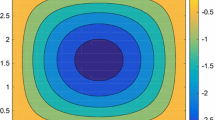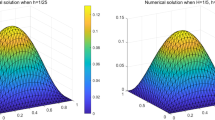Abstract
In this paper, homogenization functions are first proposed to address two-dimensional (2D) and three-dimensional (3D) inverse source problems of nonlinear time-fractional wave equation (ISPs-NTFWE). Homogenization functions for 2D and 3D problems can be derived based on proposed conditions. Then, the superposition of homogenization function method (SHFM) for tackling ISPs-NTFWE is obtained. This new scheme can directly deal with 2D and 3D ISPs-NTFWEs via resolving a linear matrix system. Importantly, the proposed SHFM has the advantage of not involving mesh generation, numerical integration, iteration, regularization and fundamental solutions. In addition, it is easy to program and implement which can achieve accurate results even for 10% noisy boundary data. Several numerical examples have been assessed to verify the accuracy of the developed method for ISPs-NTFWE.









Similar content being viewed by others
References
Acay B, Bas E, Abdeljawad T (2020) Non-local fractional calculus from different viewpoint generated by truncated M-derivative. J Comput Appl Math 366:112410
Sun H, Zhang Y, Baleanu D, Chen W, Chen Y (2018) A new collection of real world applications of fractional calculus in science and engineering. Commun Nonlinear Sci Numer Simul 64:213–231
Qiu L, Chen W, Wang F, Lin J (2019) A non-local structural derivative model for memristor. Chaos Soliton Fractals 126:169–177
Wang F, Gu Y, Qu W, Zhang C (2020) Localized boundary knot method and its application to large-scale acoustic problems. Comput Methods Appl Mech Eng 361:112729
Xi Q, Chen C, Fu Z, Comino E (2021) The MAPS with polynomial basis functions for solving axisymmetric time-fractional equations. Comput Math Appl 88:78–90
Yuanlu L (2010) Solving a nonlinear fractional differential equation using Chebyshev wavelets. Commun Nonlinear Sci Numer Simul 15:2284–2292
Sweilam N, Khader M, Al-Bar R (2007) Numerical studies for a multi-order fractional differential equation. Phys Lett A 371:26–33
Heydari M, Avazzadeh Z (2021) Orthonormal Bernstein polynomials for solving nonlinear variable-order time fractional fourth-order diffusion-wave equation with nonsingular fractional derivative. Math Methods Appl Sci 44:3098–3110
Hosseininia M, Heydari M, Avazzadeh Z (2020) Numerical study of the variable-order fractional version of the nonlinear fourth-order 2D diffusion-wave equation via 2D Chebyshev wavelets. Eng Comput. https://doi.org/10.1007/s00366-020-00995-z
Cui M (2009) Compact finite difference method for the fractional diffusion equation. J Comput Phys 228:7792–7804
Gu Y, Sun H (2020) A meshless method for solving three-dimensional time fractional diffusion equation with variable-order derivatives. Appl Math Model 78:539–549
Wang Y, Gu Y, Liu J (2020) A domain-decomposition generalized finite difference method for stress analysis in three-dimensional composite materials. Appl Math Lett 104:106226
Momani S, Odibat Z (2006) Analytical solution of a time-fractional Navier-Stokes equation by Adomian decomposition method. Appl Math Comput 177:488–494
Qin Q-H (1994) Hybrid Trefftz finite-element approach for plate bending on an elastic foundation. Appl Math Model 18:334–339
Qin Q-H (1995) Hybrid-Trefftz finite element method for Reissner plates on an elastic foundation. Comput Methods Appl Mech Eng 122:379–392
Jirousek J, Qin Q (1996) Application of hybrid-Trefftz element approach to transient heat conduction analysis. Comput Struct 58:195–201
Heydari MH, Avazzadeh Z, Haromi MF (2019) A wavelet approach for solving multi-term variable-order time fractional diffusion-wave equation. Appl Math Comput 341:215–228
Soltani Sarvestani F, Heydari MH, Niknam A, Avazzadeh Z (2019) A wavelet approach for the multi-term time fractional diffusion-wave equation. Int J Comput Math 96:640–661
Heydari MH, Avazzadeh Z, Yang Y (2019) A computational method for solving variable-order fractional nonlinear diffusion-wave equation. Appl Math Comput 352:235–248
Liu C-S, Qiu L, Wang F (2019) Nonlinear wave inverse source problem solved by a method of m-order homogenization functions. Appl Math Lett 91:90–96
Wang F, Hua Q, Liu CS (2018) Boundary function method for inverse geometry problem in two-dimensional anisotropic heat conduction equation. Appl Math Lett 84:130–136
Qiu L, Chen W, Wang F, Liu CS, Hua Q (2019) Boundary function method for boundary identification in two-dimensional steady-state nonlinear heat conduction problems. Eng Anal Boundary Elem 103:101–108
Al-Khaled K, Momani S (2005) An approximate solution for a fractional diffusion-wave equation using the decomposition method. Appl Math Comput 165:473–483
Zhang X, Zhao J, Liu J, Tang B (2014) Homotopy perturbation method for two dimensional time-fractional wave equation. Appl Math Model 38:5545–5552
Wei X, Sun L (2019) Singular boundary method for 3D time-harmonic electromagnetic scattering problems. Appl Math Model 76:617–631
Qu W (2019) A high accuracy method for long-time evolution of acoustic wave equation. Appl Math Lett 98:135–141
Jang TS, Choi HS, Kinoshita T (2000) Solution of an unstable inverse problem: wave source evaluation from observation of velocity distribution. J Mar Sci Technol 5:181–188
Ohe T, Inui H, Ohnaka K (2011) Real-time reconstruction of time-varying point sources in a three-dimensional scalar wave equation. Inverse Prob 27:115011
Li J, Fu Z, Chen W (2016) Numerical investigation on the obliquely incident water wave passing through the submerged breakwater by singular boundary method. Comput Math Appl 71:381–390
Fu Z, Chen W, Wen P, Zhang C (2018) Singular boundary method for wave propagation analysis in periodic structures. J Sound Vib 425:170–188
Liu CS, Chang CW (2019) Solving the inverse conductivity problems of nonlinear elliptic equations by the superposition of homogenization functions method. Appl Math Lett 94:272–278
Wang H, Qin QH (2006) A meshless method for generalized linear or nonlinear Poisson-type problems. Eng Anal Bound Elem 30:515–521
Liu CS, Chen YW, Chang JR (2019) Solving a nonlinear convection-diffusion equation with source and moving boundary both unknown by a family of homogenization functions. Int J Heat Mass Transf 138:25–31
Liu C-S, Qiu L, Lin J (2019) Solving the higher-dimensional nonlinear inverse heat source problems by the superposition of homogenization functions method. Int J Heat Mass Transf 141:651–657
Qiu L, Wang F, Lin J (2019) A meshless singular boundary method for transient heat conduction problems in layered materials. Comput Math Appl 78:3544–3562
Wang F, Fan C-M, Hua Q, Gu Y (2020) Localized MFS for the inverse Cauchy problems of two-dimensional Laplace and biharmonic equations. Appl Math Comput 364:124658
Qiu L, Hu C, Qin Q-H (2020) A novel homogenization function method for inverse source problem of nonlinear time-fractional wave equation. Appl Math Lett 109:106554
Qu W, Gu Y, Zhang Y, Fan CM, Zhang C (2019) A combined scheme of generalized finite difference method and Krylov deferred correction technique for highly accurate solution of transient heat conduction problems. Int J Numer Methods Eng 117:63–83
Irisarri D, Hauke G (2021) A posteriori error estimation and adaptivity based on VMS for the incompressible Navier-Stokes equations. Comput Methods Appl Mech Eng 373:113508
Qiu L, Lin J, Wang F, Qin Q-H, Liu C-S (2021) A homogenization function method for inverse heat source problems in 3D functionally graded materials. Appl Math Model 91:923–933
Hu W, Gu Y, Fan C-M (2020) A meshless collocation scheme for inverse heat conduction problem in three-dimensional functionally graded materials. Eng Anal Bound Elem 114:1–7
Gu Y, Chen W, Zhang C, He X (2015) A meshless singular boundary method for three-dimensional inverse heat conduction problems in general anisotropic media. Int J Heat Mass Transf 84:91–102
Acknowledgements
The work in this paper is supported by the National Natural Science Foundation of China (No. 12072103), the Natural Science Foundation of Jiangsu Province (No. BK20190073), the Fundamental Research Funds for the Central Universities (No. B200202126), the State Key Laboratory of Acoustics, Chinese Academy of Sciences (No. SKLA202001), and the China Postdoctoral Science Foundation (Nos. 2017M611669, 2018T110430).
Author information
Authors and Affiliations
Corresponding author
Rights and permissions
About this article
Cite this article
Lin, J. Simulation of 2D and 3D inverse source problems of nonlinear time-fractional wave equation by the meshless homogenization function method. Engineering with Computers 38 (Suppl 4), 3599–3608 (2022). https://doi.org/10.1007/s00366-021-01489-2
Received:
Accepted:
Published:
Issue Date:
DOI: https://doi.org/10.1007/s00366-021-01489-2




